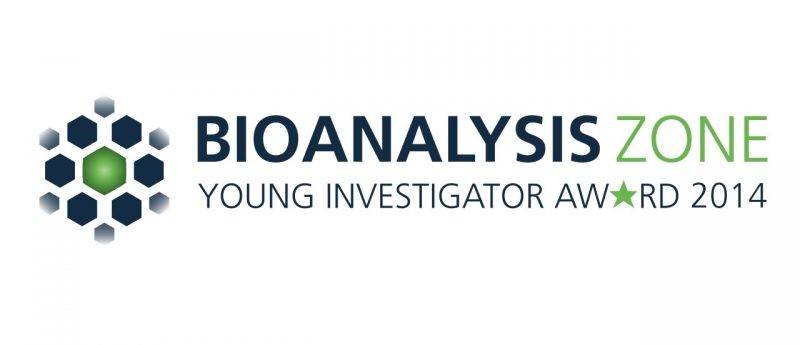2014 Young Investigator: Andrew Mayer

Nominee:
Nominated By:
Supporting Comments:
What made you choose a career in bioanalysis?
I chose a career in bioanalysis due to its applications in a range of fields, most notably the pharmaceutical industry. Being in a field on the divide between chemistry and biology poses many challenges, not only do you need a thorough understanding of the chemistry involved, but how biology creates a dynamic system that must always be considered when analyzing and interpreting data.
Describe the main highlights of your bioanalytical research, and its importance to the bioanalytical community.
My graduate research centered on the development of a seizure model in rats with subsequent measurement of neurotransmitters and amino acids. We used these techniques to monitor the changes in neurotransmitter levels following deep brain stimulation, a procedure used to reduce the number of seizures in patients, greatly improving their quality of life. My work in the pharmaceutical industry has mostly centered on the regulated bioanalysis of protein therapeutics, from peptides to antibodies.
Describe the most difficult challenge you have encountered in the laboratory and how you overcame it.
For many immunoassays, one of the most difficult challenges is to remove matrix interferences. This is typically done by diluting away the interferences. With large molecules, extractions will often remove the analyte of interest (proteins). One of the challenges with diluting the sample to remove interferences is that often the analyte is at low concentrations to begin with, so there is a balancing act between diluting the sample to accurately measure it, while at the same time diluting so much that the analyte can no longer be detected. One project, involving a peptide which has traditionally been measured by immunoassays, is problematic due to the low concentrations, as well as the presence of an endogenous binding protein. Measurement of this peptide varies significantly between different reagents, as well as across platforms (LC–MS/MS versus ELISA). A sample extraction procedure, including both an acid treatment to dissociate the peptide from the endogenous binding protein, as well as a protein precipitation was employed. The sample was dried down and reconstituted in the immunoassay buffer and analyzed using a sandwich immunoassay. The selectivity of the assay was much improved over the same assay without a sample clean-up step.
Where do you see your career in bioanalysis taking you?
I am somewhat unique in that my graduate work involved small molecular weight species (mainly neurotransmitters) and my work in the pharmaceutical industry has mostly centered around the use of immunoassays for the determination of large molecular weight proteins. I hope to use this to my advantage when continuing to investigate the use of sensitive immunoassay reagents couple with LC–MS. There are many puzzles that cannot simply be solved with the use of one or the other. Concentrations in the body are too low to be measured by LC–MS/MS, however the available reagents for immunoassays are either not available, or not of high quality. I have also been lucky to have had great mentors thus far in my career and I look forward to the opportunity to do the same for those who are younger than myself. There is only so much that can be done within my career, but I look to share my experiences and knowledge so that much can be done in the future.
How do you envisage the field of bioanalysis evolving in the future?
The field of bioanalysis is moving towards the measurement of large molecular weight proteins. With an increased interest in the development of protein therapeutics, there is a push for both sensitive and selective methods for the quantitation of these proteins in biological fluid. Historically, proteins have been measured by immunoassays due to the use highly sensitive antibody reagents. However, the selectivity of the method has been an issue. With the use of LC–MS for the analysis of small molecular weight compounds, scientists have been investigating its use for large molecular weight compounds, due to its enhanced selectivity. However, there has been a gap between the sensitivity provided by immunoassays and selectivity provided by LC–MS/MS. This is beginning to change, however with better increased technology and sample clean-up for protein therapeutics. Hyphenated techniques, utilizing an immune capture followed by LC–MS/MS have combined both the sensitivity of immunoassays with the selectivity of LC–MS/MS. Technology will continue to advance for the detection of large molecular weight molecules with picogram and femtogram concentrations.
Please list 5 of your recent publications, and select one that best highlights your career to date in the field of Bioanalysis.
1. Crick E, Osorio I, Frei M, Mayer A, Lunte C. Correlation of 3-mercaptopropionic acid induced seizures and changes in striatal neurotransmitters monitored by microdialysis. Eur. J. Pharm. Sci. 57, 25–33 (2014).
2. Mayer A, Osorio I, Lunte C, Microperfusion of 3-MPA into the brain augments GABA. Epilepsy Behav. 29(3), 478–484 (2013).
3. Mohamed A, Abdou H, Mayer A, Fackler JP Jr. A Silver(I)–gold(II) hexanuclear guanidinate–benzoate cluster with short Au–Au bonds. Journal of Cluster Science 19(4), 551–559 (2008).
4. Mohamed A, Mayer A, Abdou H, Irwin M, Pérez L, Fackler JP Jr. Dinuclear and tetranuclear gold−nitrogen complexes. Solvent influences on oxidation and nuclearity of gold guanidinate derivatives. Inorg. Chem. 46(26), 11165–11172 (2007).
First choice: Mayer A, Osorio I, Lunte C, Microperfusion of 3-MPA into the brain augments GABA. Epilepsy Behav. 29(3), 478–484 (2013).
Reasoning: This paper is counterintuitive to the main thought that epileptic seizures are mainly due to an increase in excitation with a concurrent decrease in inhibition in the brain. This paper demonstrated that epileptiform activity can occur with both an increase in excitation and inhibition, as long as there is a larger absolute increase in excitation.





